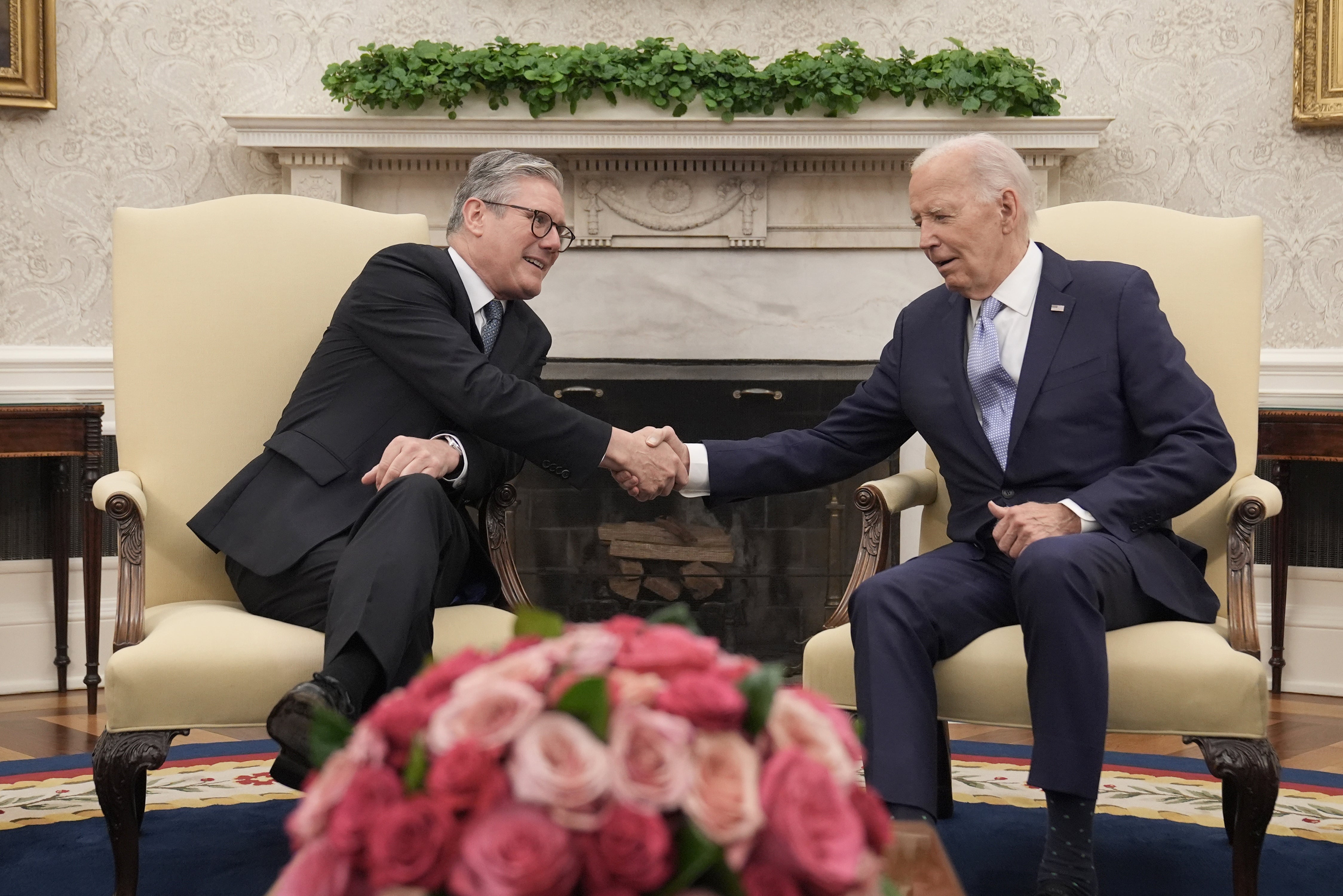What Starmer’s Washington visit could mean for Ukraine
The prime minister’s trip to the White House could provide an answer to President Zelensky’s prayers to use Western-made long-range missiles, writes Mary Dejevsky


For once, a UK prime minister’s visit to Washington could offer more than the usual formulaic courtesies and obligatory references to the “special relationship”. Sir Keir Starmer’s meeting with President Biden at the White House could provide the opportunity for the US to announce that it is acceding to Ukraine’s long-standing pleas to use US- and UK-supplied missiles to strike targets deep inside Russia.
It is a perilous moment, and those with longer memories might sense the ghosts of another fateful UK-US encounter haunting the scene: the meeting between Tony Blair and George W Bush at Camp David in September 2002, where Blair gave Bush a degree of international cover, in the form of his unconditional support, for the invasion of Iraq.
Then again, Biden may continue to prevaricate, and the UK will have no choice but to do the same. What cannot be said, however, is that any decision lacks preparation.
Starmer’s visit to Washington was preceded by a highly unusual joint visit to Kyiv by the US secretary of state, Antony Blinken, and the UK foreign secretary, David Lammy. It came at what Blinken described, after a day of talks in London, as “a critical moment for Ukraine”. As indeed it is – with Ukraine losing ground in the east and its troops increasingly marooned after their sortie into Russia’s Kursk region – developments that also make this a critical moment for Ukraine’s allies in Europe, and the United States.
As to the purpose of the Kyiv trip, Blinken said that one goal was “to hear direct from the Ukrainian leadership” about “their objectives and what we can do to support those needs”, which was pretty non-committal. At the end of a long meeting with President Zelensky and his team, Blinken and Lammy announced relatively small amounts in new assistance. They rebuffed all questions about any movement on the use of US ATACMS and UK Storm Shadow missiles and said they would be reporting back to their bosses in Washington and London.
The current US position is that the long-range missiles in question may be used only against Russian targets that threaten Ukraine from the immediate border areas of Russia. Ukraine’s argument, spearheaded in recent weeks by President Zelensky, is that it needs the deeper strikes to thwart the Russian glide bomb attacks, which have been systematically destroying Ukraine’s energy infrastructure. It insists that this is the only way Ukraine will have any chance of victory – and there are many in the West, and notably in the UK, who agree.
Listening was not the only purpose of the Blinken-Lammy day trip to Kyiv, however. It was clearly designed also as a show of unity between Ukraine’s two most prominent Western backers after several months of confused signalling by the UK about whether Ukraine could use British Storm Shadow missiles to strike targets far into Russia.
Back in May, the then foreign secretary, Lord Cameron, had appeared to say they could. This was followed by a pledge of policy continuity from the new Labour government, which Ukraine appeared to interpret as giving the green light to the use of the missiles, only for this to be almost immediately overruled – somewhat abruptly, or so it seemed – by the US, prompting unusual public criticism of the UK from a disappointed Zelensky.
This not-so-little spat has now apparently been settled, with the UK adopting a new phrase that qualifies the UK’s Ukraine-policy as “Nato First” – a term used by David Lammy at his London press conference with Blinken and by the defence secretary, John Healey, in his House of Commons statement on Ukraine the same day. It appears to mean that the UK agrees not to go “off-piste” in its military relations with Ukraine and accepts that Nato – ie the United States – will always have the last word.
If the joint UK-US visit to Kyiv closed that particular chapter, however, it opened another, which appeared to set up the rationale that the US – and its allies – might use in defence of any decision to free Ukraine to strike targets in Russia.
It was clear that there were two points Blinken and Lammy were concerned to get across. One was what they presented as the changed situation, now that Iran had agreed to supply Shahed drones to Russia – a development that has also drawn new US and UK sanctions against Iran.
The other point concerned what was said to be the increased incidence of hostile Russian activity affecting Nato countries. The new Ukrainian foreign minister, for instance, who was also at the press conference, stressed what he said was the growing number of Russian missiles and drones landing on Nato territory, including Romania.
It has to be said there is less than complete clarity either about the effect of Iranian drones on Russia’s war or about alleged Russian strikes into Nato territory. The latter is, in fact, a reprise of an episode in the first autumn of the war, when Ukraine called for a Nato response to what it said was a Russian missile strike just inside Poland (which turned out to be a misfired Ukrainian missile).
The likely purpose of such claims, however, is evident – as justification for a change in the conditions attached to Ukraine’s use of its long-range missiles, and the need to respond to a direct threat to Nato security. What we have here is a rehearsal of the rationale that could well be deployed by the US and the UK to convince worried allies, if and when a decision is taken on Ukraine’s requests to strike Russia.
Even then, it will not be an easy argument to have, one indication being the number of high-level meetings that have taken place in the past 10 days or so. They include the unprecedented joint appearance on a public stage of the head of MI6, Richard Moore, and the CIA director, William Burns (which was surely augmented by at least one private meeting). There was an extraordinary meeting in Washington between a high-level Ukrainian delegation and the national security advisers of the US, and the UK, as well as France and Germany. And at the end of last week, there was a meeting at Ramstein near Frankfurt of the group that coordinates international help for Ukraine.
Among Nato countries, Germany could be a particular obstacle to any relaxing of the rules on Ukraine’s use of missiles. Chancellor Olaf Scholz faces growing opposition to Germany’s help for Ukraine, as shown in recent regional election results, and has personally refused Ukrainian requests for Taurus missiles, on the grounds that they would need German personnel to maintain them and he will not expose German troops to that risk.
France could also be a problem, given that President Macron, who was once a cheerleader for more Western intervention, is now otherwise engaged in a political crisis that may or may not have been resolved with the appointment of Michel Barnier as prime minister.
From all this, it is not hard to extrapolate an all too familiar scenario. A UK prime minister setting off for the United States; the UK being feted as the United States’ closest ally, and the prospect of the UK, once again perhaps, giving the US a semblance of international cover for a potentially risky military decision.
It will be worth not only listening to the public statements of both leaders at the end of their meeting, but examining the small print of any agreements as well. And stand by, if there is a decision to free Ukraine’s hand on the use of its Western-supplied long-range missiles, for Russia’s response.






Join our commenting forum
Join thought-provoking conversations, follow other Independent readers and see their replies
Comments